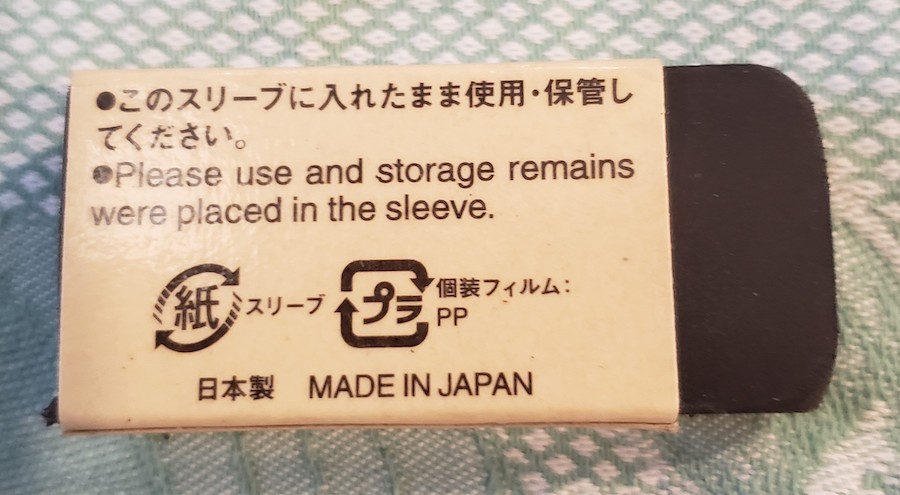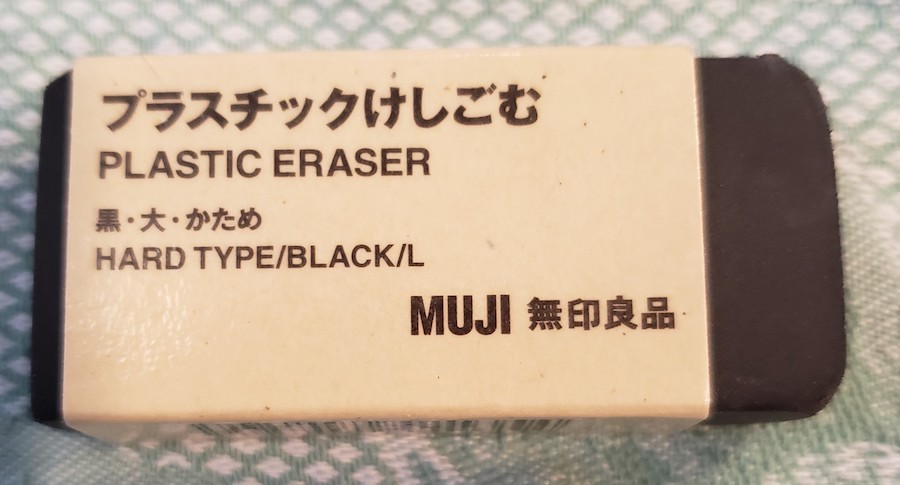Eraser from Muji
« previous post | next post »
From Anne Henochowicz:
Kono surību ni ireta mama shiyō• hokan shite kudasai.
このスリーブに入れたまま使用•保管してください。
("Please keep and use [the eraser] in this sleeve.")
—
Purasuchikku keshigomu
プラスチックけしゴム (the second word could also be written keshigomu 消しゴム)
("Plastic eraser.")
—
kuro• dai• katame
黒•大•かため
("Black•large•hard")
—
MUJI Mujirushi ryōhin
MUJI 無印良品
("no trademark good product")
—
pura
プラ
("plastic")
[Thanks to Frank Chance]


Bathrobe said,
November 24, 2019 @ 12:36 am
The problem is まま mama, which means 'as it is', 'without change'.
このスリーブに入れたまま kono surību ni ireta mama means 'as (it is) inserted in the sleeve' or 'remaining inserted in the sleeve'.
I assume this has been translated into English as 'remains' (i.e., 'remaining as it is').
JB said,
November 24, 2019 @ 2:29 am
Does this "gomu" come from the French "gomme" by any chance?
Philip Spaelti said,
November 24, 2019 @ 2:50 am
@JB: via Dutch
John J Chew said,
November 24, 2019 @ 11:43 am
It's a good example of how Japanese is best translated into English while reading sentences from back to front:
kudasai=please
shite=do
hokan=store
•=and/or
shiyō = use
[ ] = this
mama = keeping
[ ] = it
ireta = inserted
ni = in
[ ] = the
surību = sleeve
no = of
ko = this
[ ] = thing
Brian Datsun said,
November 25, 2019 @ 2:46 am
Also interesting to note here how this eraser shows Japanese recycling rules.
the 紙 shows that the スリーブ (sleeve) needs to be thrown out with paper / cardboard garbage while the プラ shows that the 個装フィルム (individual packaging film) which presumably refers to a little plastic film that the eraser was originally wrapped in needs to be put with the plastic recycling.
JC said,
November 25, 2019 @ 4:28 am
I never thought about the derivation of gomu ゴム before. Apparently from Dutch gom, eraser.
Frank L Chance said,
November 26, 2019 @ 8:52 am
ゴム "gomu" seems to me to come from the English "gum" and generally means "rubber," both in the sense of the action used when erasing but also the product. Other examples of it in Japanese include ゴム靴 "gomugutsu" rubber shoes, i.e. rain boots or Wellies (not to be confused with "gumshoe," the American slang for a detective), and ゴムバンド "gomubando" rubber band.
Josh Reyer said,
November 26, 2019 @ 7:31 pm
Frank L. Chance –
If it was derived from English "gum", it would use either pronunciation (ガム, gamu) or spelling (グム, gumu) to create the Japanese pronunciation. Indeed, the Japanese for "gummy", as in gummy candy, follows the English spelling (グミ, gumi).
As JC noted, ゴム "gomu" derives from Dutch "gom".
https://dictionary.goo.ne.jp/word/%E3%82%B4%E3%83%A0/#jn-82095
Philip Spaelti said,
November 27, 2019 @ 4:18 am
European loans which predate the Meiji period are almost exclusively from Dutch and Portuguese. You can tell that gomu ゴム/ごむ is from Dutch not just because of the vowel, but also because they are comfortable writing the word in Hiragana. Perhaps the main surprise here is that erasers and latex are things that were introduced to Japan (and Europe) that long ago.
The Dutch word itself is borrowed from (Old) French, as is the English word gum.
Michèle Sharik Pituley said,
November 29, 2019 @ 11:27 am
Frank L. Chance wrote: ゴムバンド "gomubando" rubber band
Did they get that from Pennsylvania where they say "gum band" instead of "rubber band"? Lol
Rodger C said,
December 2, 2019 @ 9:35 am
I'd think グミ for gummy candy was from German, like the candy.